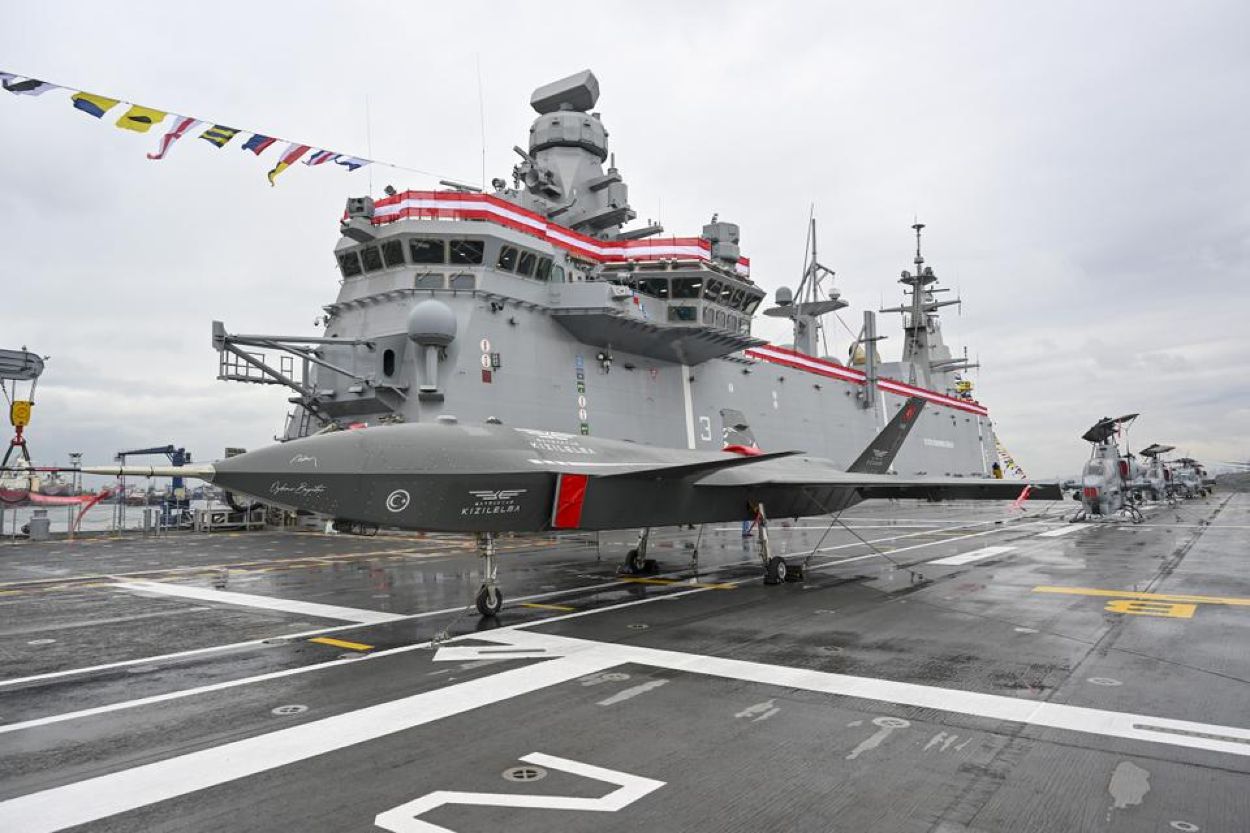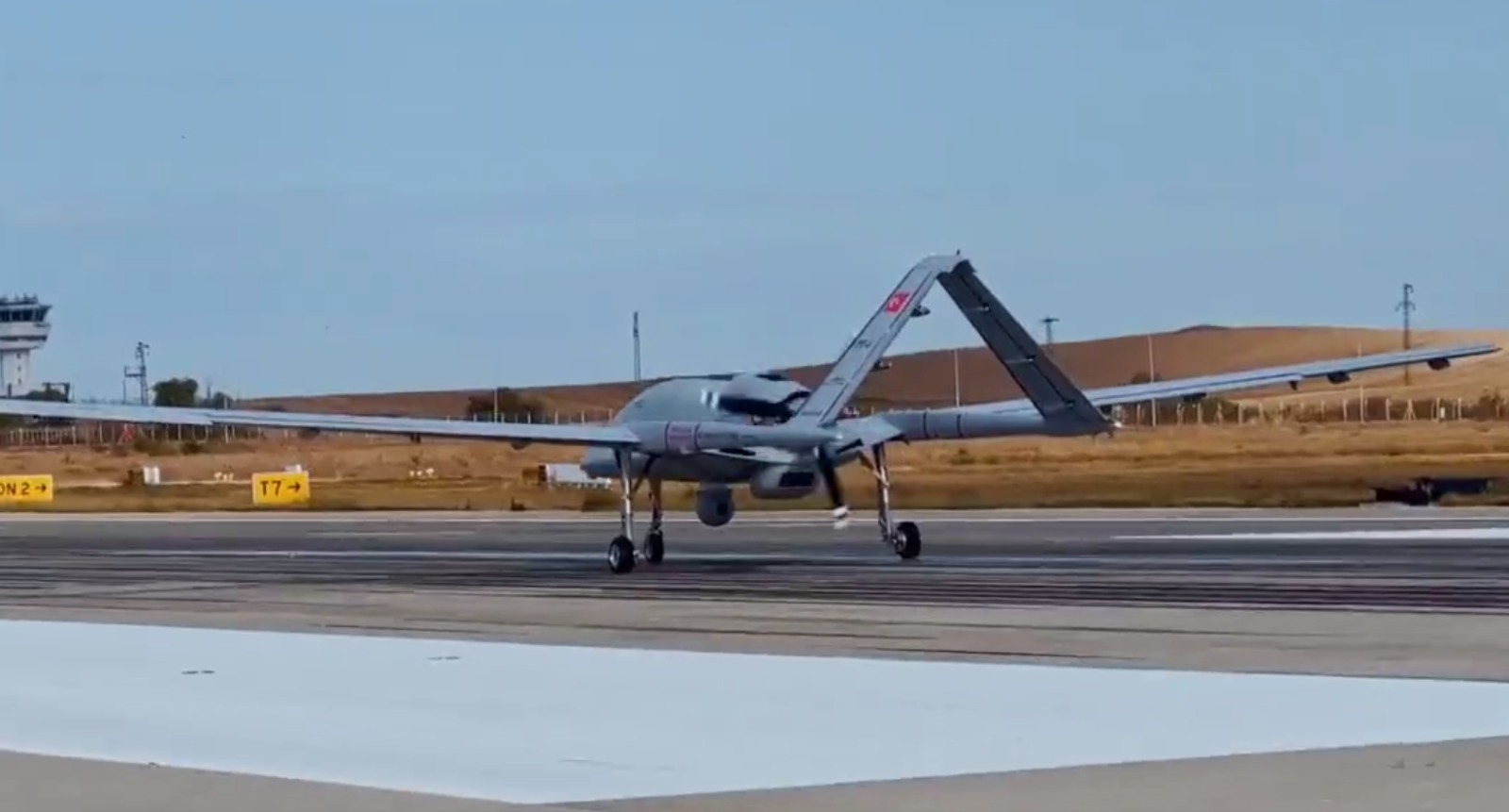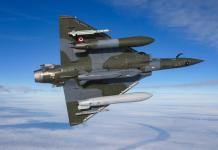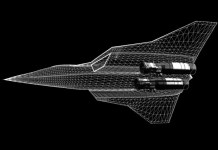Months after taking off to the skies for the first time, Turkey’s carrier-capable drone Bayraktar TB3 Unmanned Aerial Vehicle (UAV) has conducted its first ski-jump test from a land-based runway.
The test serves as a crucial stage in the development of the Bayraktar TB3, a carrier-capable drone manufactured by Baykar, which began flight testing from TCG Anadolu last year. TCG Anadolu was commissioned into service last year and is believed to be one of the world’s first drone carriers.
The Bayraktar TB3 is the carrier-tailored version of the TB2 drone, which has been extensively used in a host of combat zones globally. With foldable wings and the ability to take off from short runways, the TB3 is set to become the first combat drone in history capable of launching and landing on a short runway like the TCG Anadolu.
In a company-released video, the drone is seen taking off from an upward-curved ramp in Edirne, northwest Turkey, and rolling out on a runway under conditions that the company said were similar to the TCG Anadolu.
The TB3 executed four successful takeoffs from a 12-degree inclined ramp that mirrored the ship’s deck. Selçuk Bayraktar, Baykar’s chair and technology leader, wrote on social media platform X: “Step by step to TCG Anadolu. And from there to the boundless blue seas.”

The drone will continue its testing from the Baykar Flight Training and Test Center in the Keşan neighborhood of Edirne, which has a dedicated ramp runway, as per the plans laid out by the manufacturer.
The drone was unveiled in March 2023 when Selcuk Bayraktar shared pictures of the Bayraktar TB3 on the production line. Months later, the drone completed its maiden flight in October 2023 to mark 100 years of Turkey and its military innovation.
Adım adım TCG-ANADOLU'ya,
Oradan da eşsiz maviliklere…🌊#BayraktarTB3 46. Test Uçuşu | 46th Flight Test ✈️ ⚓️🚀✅ Rampa Kalkış Testi | Ski-Jump Test #MilliTeknolojiHamlesi 🌍🇹🇷 pic.twitter.com/83lVciUVwm
— Selçuk Bayraktar (@Selcuk) June 1, 2024
The TB3 drone made headlines when it completed an impressive 32-hour flight during testing in December last year. That established a new flight endurance record within the Bayraktar UAV or Bayraktar UCAV family. According to reports, the drone has clocked in over 395 hours of flight time during its test flights. The TB3 will fly alongside the Bayraktar Kizilelma, a carrier-capable “unmanned fighter jet.”
The operation of a combat drone from a drone carrier is significant since no other country has that capability yet. The TCG Anadolu is described as a “multipurpose amphibious assault ship”, which would also be the world’s first vessel with an air wing consisting of unmanned aircraft.

The ship was ordered in 2015, laid down in February 2018, launched in April 2019, and commissioned in April 2023. The Anadolu intended to undertake “sustaining long-endurance, long-distance military combat, or humanitarian relief operations while acting as a command center and flagship for the Turkish Navy.”
The ship’s air wing is expected to comprise mostly Bayraktar TB3s, a short-runway-capable version of the renowned Bayraktar TB2 developed by Baykar. The Kizilelma, another of Baykar’s unmanned combat aerial vehicles (UCAV) — or the “unmanned fighter jet as Turkey describes it — will also operate from the carrier.
The development and testing of the TB3 drone are being keenly watched after the combat success recorded by its predecessor, Bayraktar TB2, in a host of war zones, including Syria, Libya, Nagorno-Karabakh, and Ukraine.
Comprehensive testing is still needed to determine the TB3’s performance, particularly in naval combat. Though it has more capabilities than its predecessor, the TB3 would also be designated for exports in addition to its domestic maritime deployment.
TB3 Is Coming; It’s Bigger & Better
The Bayraktar TB3 is an armed aerial vehicle system that can take off and land on aircraft carriers. Using the smart weapons under its wings, the TB3 UCAV can conduct assault operations besides intelligence, reconnaissance, and surveillance missions.
The drone, marking a substantial advance from its predecessor, the TB2, offers enhanced flight endurance, striking capabilities, intelligence, surveillance, and reconnaissance (ISR) functions.
The Bayraktar TB3 drone has unique features. Its foldable wings, akin to those seen on naval fighter jets, allow it to be used on aircraft carriers and conduct military operations overseas. With six hardpoints positioned beneath its foldable wings, the drone can carry an array of munitions. This includes precision weaponry such as laser-guided rockets, anti-infantry bomblets, and formidable anti-tank missiles.
The TB3 is capable of Fully Autonomous Take-Off and Landing. Further, the Bayraktar TB3’s line-of-sight and beyond-line-of-sight communications capabilities allow it to be operated from very far away locations.

It is 8.3 meters long, 2.6 meters tall, and has a 14-meter wingspan. That means it is bigger than the TB2 which measures 6.5 meters in length, 2.2 meters in height, and a 12-meter wingspan.
Additionally, the payload capacity of the new TB3 UAV, at 280 kilograms, is far larger than that of the TB2, which has a payload of 150 kilograms. The maximum takeoff weight of the TB-3 is 1,450 kilograms, about twice that of the TB-2, which is 700 kilograms.
The TB3 dominates the TB2 in terms of cruising speed. It can cruise at 125 to 160 mph, while the TB2 can only fly between 70 and 120 knots. If the official specifications released by the manufacturer are any indication, the TB3 is a significant improvement.
The December testing of the TB3, which put the spotlight on the endurance, indicated that it has an endurance level surpassing the typical range observed in most Medium Altitude Long Endurance (MALE) class Unmanned Combat Aerial Vehicles (UCAVs), typically spanning 24 to 27 hours.
- Contact the author at sakshi.tiwari9555 (at) gmail.com
- Follow EurAsian Times on Google News




